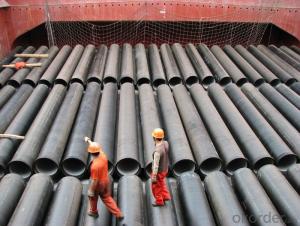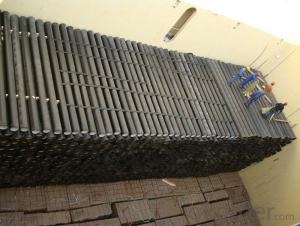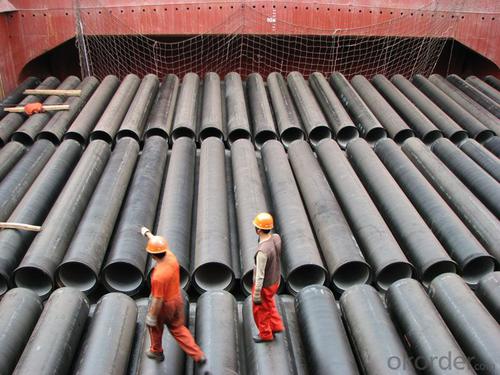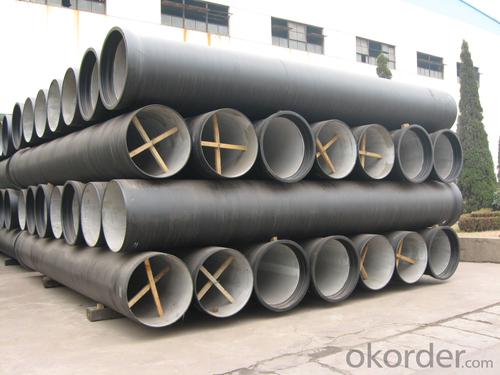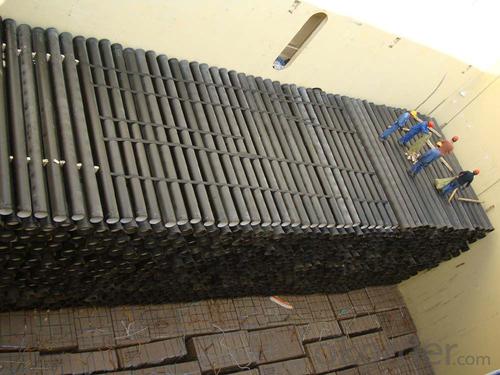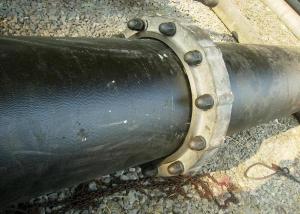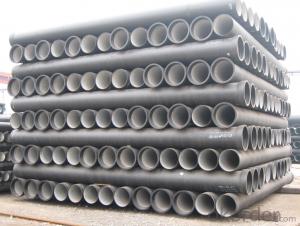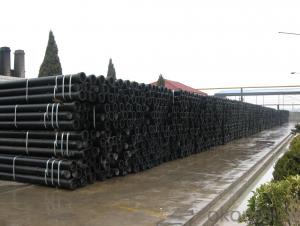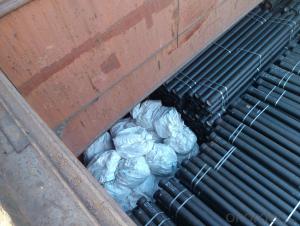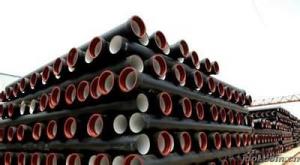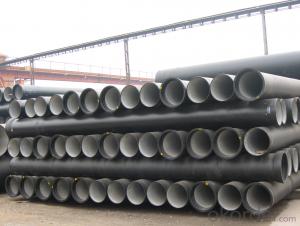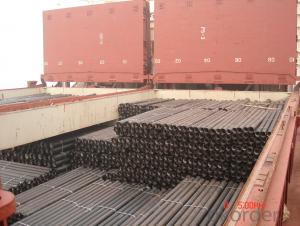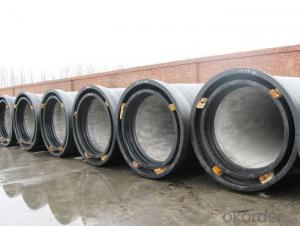DUCTILE IRON PIPE DN80 K9/C/K8
- Loading Port:
- China Main Port
- Payment Terms:
- TT OR LC
- Min Order Qty:
- -
- Supply Capability:
- -
OKorder Service Pledge
OKorder Financial Service
You Might Also Like
Specification:
1) The standard of pipe: ISO2531:1998, K9
2) Effective length: 6m
3) Inner cement line: Portland cement line as per ISO4179
4) Zinc coating: at least 130g/m2 as per ISO8179
5) Bitumen painting: at least 70um as per ISO8179
6) With 100% quantity of NBR ring, or SBR ring, or EPDM ring as per ISO4633
7) DN80mm-800mm
8) High strength, lighter than grey iron, good corrosion resistance, no furring, small flow resistance, easy fixing, long life tome about 100 yeas
9) Produced by Hangzhou chunfeng machine
10) Checked by automatic inspection equipment
11) Composition:
Chemical composition | | | | |||
Chemical composition | Ductile Cast Iron Pipe (%) | Grey iron pipe (%) | Steel pipe (%) | | | |
C | 3.5-4.0 | 3.2-3.8 | 0.1-0.2 | | | |
Si | 1.9-2.6 | 1.4-2.2 | 0.15-0.4 | | | |
Mn | 0.15-0.45 | 0.4-0.6 | 0.3-0.6 | | | |
P | ≤0.06 | ≤0.3 | 0.02-0.03 | | | |
S | ≤0.02 | ≤0.1 | 0.02-0.03 | | | |
Mg | 0.03-0.06 |
|
| | | |
12) Feature:
Mechanical properties | | | | |||
| Ductile Cast Iron Pipe | Grey Iron Pipe | Steel Pipe | | | |
Tensile Strength(Mpa) | ≥420 | 150-260 | ≥400 | | | |
Yield Strength(Mpa) | ≥300 | No Confirmation | No Confirmation | | | |
Bending Strength(Mpa) | ≥590 | 200-360 | ≥400 | | | |
Elongation (%) | ≥10 | Neglected | ≥18 | | | |
Brinell Hardness(HBS) | ≤230 | ≤230 | About 140 | | | |
13) T type mechanical joint
14) Packing: in bulk or container
- Q: Are ductile iron pipes suitable for mining applications?
- Yes, ductile iron pipes are suitable for mining applications. Ductile iron pipes are known for their strength, durability, and resistance to corrosion, making them ideal for underground mining operations. They can withstand high pressure, heavy loads, and abrasive materials commonly found in mining environments. Additionally, their flexible nature allows for easy installation and maintenance in challenging mining conditions.
- Q: Fire water supply network adopts ductile iron pipe, the test pressure should be no more than MPa
- Strictly speaking: the outer pipe network and the internal pipe network are the same. Minimum fire 1.0MPa, minimum sprinkler 1.4MPa. Because not only in accordance with the water pump, but also take into account the pressure on the fire engine.
- Q: What is the maximum allowable joint deflection for ductile iron pipes?
- The maximum allowable joint deflection for ductile iron pipes is typically specified by industry standards and guidelines. These standards may vary depending on the specific application and local regulations. In general, the maximum allowable joint deflection for ductile iron pipes is usually limited to a range between 1% to 5% of the pipe diameter. This means that the pipe can typically tolerate a deflection of up to 1% to 5% of its diameter without causing any significant damage or compromising its structural integrity. However, it is important to note that the exact maximum allowable joint deflection may vary depending on factors such as pipe size, wall thickness, and operating conditions. It is recommended to consult the relevant industry standards, such as those published by the American Water Works Association (AWWA) or the International Organization for Standardization (ISO), for specific guidelines on maximum allowable joint deflection for ductile iron pipes in a given application.
- Q: Are ductile iron pipes suitable for irrigation systems in agricultural fields?
- Yes, ductile iron pipes are suitable for irrigation systems in agricultural fields. Ductile iron pipes have excellent strength, durability, and corrosion resistance, making them ideal for carrying water in irrigation systems. They can withstand high pressure and heavy loads, ensuring reliable water supply to agricultural fields for irrigation purposes.
- Q: What's the advantage of FCD50 ductile iron?
- Ductile cast iron pipes are called ductile iron pipes.
- Q: Can ductile iron pipe be used in areas with high groundwater levels?
- Yes, ductile iron pipe can be used in areas with high groundwater levels. Ductile iron pipe is known for its durability and strength, making it suitable for use in various applications, including areas with high groundwater levels. Its corrosion resistance properties make it highly resistant to the corrosive effects of groundwater, ensuring long-term performance and reliability. Additionally, ductile iron pipe's joint flexibility allows it to withstand ground movement and settlement caused by fluctuating groundwater levels. Therefore, it is a suitable choice for areas with high groundwater levels, providing a reliable solution for water distribution systems and other underground applications.
- Q: Are ductile iron pipes more resistant to breaks and cracks than other pipe materials?
- Yes, ductile iron pipes are generally more resistant to breaks and cracks compared to other pipe materials. Their unique composition and manufacturing process make them highly durable and flexible, allowing them to withstand high pressure, heavy loads, and ground movement without breaking or cracking easily.
- Q: How does ductile iron pipe perform in areas with high groundwater contamination?
- Ductile iron pipe performs well in areas with high groundwater contamination due to its corrosion-resistant properties. It can withstand the corrosive effects of contaminated water and maintain its structural integrity over time, making it a reliable choice for such environments.
- Q: Can ductile iron pipes be used for underground wastewater outfalls?
- Yes, ductile iron pipes can be used for underground wastewater outfalls. Ductile iron is a strong and durable material that can withstand the harsh conditions of underground installations, making it suitable for transporting wastewater efficiently and reliably.
- Q: Are there any limitations to the length of ductile iron pipe sections?
- Limitations exist regarding the length of ductile iron pipe sections. Typically, these limitations stem from practical concerns such as transportation, installation, and handling. Longer pipe sections can present difficulties when it comes to transportation and maneuverability, particularly in areas with limited access or challenging terrain. Moreover, longer pipe sections may be more susceptible to damage during installation since proper alignment and joining can be more challenging. Manufacturing capabilities also impose limitations. Ductile iron pipes are typically produced in standard lengths, which can vary depending on the manufacturer and the specific application. These standard lengths are designed to strike a balance between transportation, installation, and overall pipe performance. In addition, longer pipe sections may pose challenges related to temperature variations and subsequent expansion and contraction. Ductile iron pipes are prone to thermal expansion and contraction, and longer sections may experience greater stress and strain as a result. Therefore, while there is no definitive maximum length for ductile iron pipe sections, practical considerations and manufacturing capabilities dictate the use of standard lengths that consider various factors such as transportation, installation, and performance.
Send your message to us
DUCTILE IRON PIPE DN80 K9/C/K8
- Loading Port:
- China Main Port
- Payment Terms:
- TT OR LC
- Min Order Qty:
- -
- Supply Capability:
- -
OKorder Service Pledge
OKorder Financial Service
Similar products
Hot products
Hot Searches
Related keywords
